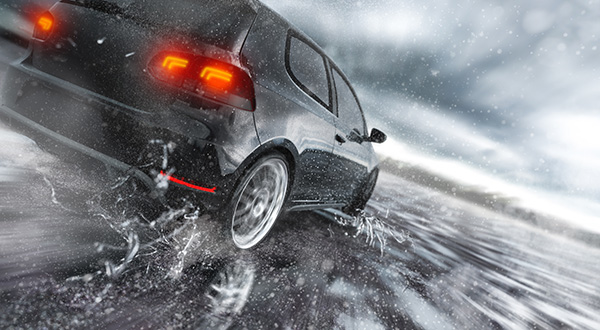
Driving through standing water might not seem like a big deal—until your tires suddenly lose contact with the road. One second, you’re in control; the next, your steering feels loose, and the car starts to slide. That’s hydroplaning, and it can catch even experienced drivers off guard.
It doesn’t take much water or high speed for it to happen, and once it does, regaining control can be difficult. Knowing what causes hydroplaning—and how to handle it will help you stay safer when wet weather hits.
What Is Hydroplaning
Hydroplaning occurs when your tires can’t push water away fast enough to maintain contact with the road. Instead, they glide on top of the water like skis, creating a thin barrier between the rubber and the pavement. At that point, your car loses traction—and you lose control.
You may still be able to steer slightly, but braking becomes unpredictable, and turning suddenly can send the car into a spin. Hydroplaning can affect any vehicle, regardless of size or drivetrain, and it often catches drivers off guard because it happens fast and without warning.
Speed Is the Key Factor
While hydroplaning can technically happen at speeds as low as 35 mph, it becomes far more likely above 55 mph, especially when your tires are worn or underinflated. The faster you’re going, the less time your tires have to channel water through the tread grooves.
That’s why standing water—whether it’s a large puddle, a flooded lane, or a low spot on the highway—is especially dangerous at high speed. You may not even realize it’s there until it’s too late to slow down, and once hydroplaning starts, sudden braking or sharp steering only makes things worse.
What It Feels Like When You Hydroplane
Most drivers describe hydroplaning as a floating or sliding sensation, where the car feels like it’s drifting without input. The steering may feel light or disconnected, and the engine sound might change if the tires start to spin.
It often happens when switching lanes through puddles or during heavy rain. Even if the vehicle doesn’t spin or skid, the momentary loss of control is enough to cause panic—especially on busy roads.
How to React If It Happens
The most important thing to do when your car hydroplanes is to stay calm and avoid overreacting. Here’s how to handle it:
- Ease off the accelerator to let the vehicle slow naturally.
- Don’t slam on the brakes—this can make the skid worse, especially in vehicles without ABS.
- Keep the steering wheel steady and avoid sudden movements.
- Wait for the tires to reconnect with the road—once you feel traction return, you can begin to slow down more confidently.
- If the rear of the car begins to fishtail, gently steer in the direction you want to go—but resist the urge to jerk the wheel or overcorrect.
Tire Condition Matters More Than You Think
Your tires are the only thing between your car and the road. Worn-out tread, improper inflation, or tires not rated for wet conditions all increase your risk of hydroplaning. Even tires that look “okay” might not provide the grip you need during heavy rain.
Routine checks for tread depth, pressure, and alignment go a long way toward keeping you safe. Many experts recommend replacing tires when the tread depth reaches 4/32", especially if you regularly drive in wet weather.
In areas like Maryland and Delaware, where summer storms can flood roads quickly, good tires aren’t just nice to have—they’re essential.
Don’t Forget Road Design and Vehicle Factors
Some roads are more prone to water buildup than others—especially poorly drained highways, older asphalt, or construction zones. Wide, flat tires and lightweight vehicles may hydroplane more easily, while heavier vehicles with proper tire pressure tend to maintain better contact.
Cruise control can also be dangerous in wet conditions. If you're using it and your car begins to hydroplane, the system may continue accelerating, making it harder to regain control. Always turn off cruise control when the road is wet, or visibility is limited.
Worried about how your vehicle will handle the next downpour? Stop by Admiral Tire and Auto of Edgewater for a full inspection of your tires, brakes, and suspension. Whether you're in Maryland or Delaware, our expert team will help you prepare your car for wet roads and standing water in one of our locations:
- Edgewater, MD
- Mitchellville, MD
- Denton, MD
- Newark, DE
- Upper Marlboro, MD
Call your nearest shop or schedule your appointment today!